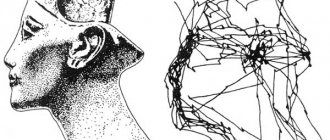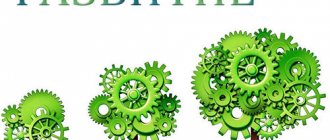What are mental processes and what are they like?
Mental processes are one of the key concepts of modern psychology. The human psyche is considered as an integral structure, but to facilitate its study, several groups of mental phenomena are distinguished:
- mental processes
- mental properties
- mental states
Note 1
Classification of mental phenomena is needed only from a methodological point of view, since the human psyche is one and these phenomena do not exist and do not function separately.
Mental processes are a group of mental phenomena that are united according to the functions they perform in the human mental system. Distinctive characteristics of mental processes are:
Are you an expert in this subject area? We invite you to become the author of the Directory Working Conditions
- dynamism
- short duration
- fast flow
All of them are a response to what is happening.
Mental processes can be:
- inferior
- higher
Lower mental processes are otherwise called natural. They are non-mediated and are formed without the participation of the cultural environment. At their core, they are a product of natural development. The control of these mental functions occurs involuntarily. A person cannot consciously interfere with this process. Examples of natural mental functions are:
- mechanical memory
- involuntary attention
- generative imagination
Higher mental processes are complex systemic mental processes that are formed throughout life and have a social origin. Examples of higher mental processes include:
- logical memory
- voluntary attention
- creative imagination
- conceptual thinking
- speech
Article:
Higher mental functions (HMF) are specific mental functions of a person.
These include: memory, attention, thinking, perception, imagination and speech. The famous Russian psychologist, Lev Semyonovich Vygotsky, wrote: “The highest mental function appears on the stage twice: once as an external, interpsychic (i.e., a function divided between a child and an adult), and the second – as an internal, intrapsychic (i.e. . function belonging to the child himself).” A small child is not yet able to focus attention for a long time, remember and correctly pronounce the names of certain objects, etc., so the role of an adult during this period is to be an intermediary between the baby and the outside world. Thus, an adult acts as the child’s basic mental functions, reminding him of the names of phenomena and objects, concentrating his attention, developing thinking and speech. Then, in the process of growing up, the child gradually inherits social experience and becomes able to use it independently. Thus, from Vygotsky’s point of view, the process of development is a process of transition from the social to the individual. It should be noted that the process of development of higher mental functions begins long before the child enters school, even in infancy. Young children learn constantly: in play, while walking, watching their parents, etc.
However, there are certain phases in a child's development when he or she is especially receptive to cognition and creativity. Such periods in a baby’s life are called sensitive (literally “sensitive”). Traditionally, these periods include the process of child development from 0 to 7 years. In Russian psychology and pedagogy, this period is considered the most productive in terms of the child’s assimilation of social experience and the acquisition of new knowledge. At this stage, the foundation is laid not only for the behavioral and emotional-volitional, but also for the cognitive sphere of a person’s personality.
So, let's now talk about the basic exercises and technologies used by teachers in the development of higher mental functions in children of preschool and primary school age. Let's give short examples from daily practice.
Thinking.
Mental operations include the processes of generalization, analysis, synthesis and abstraction. Accordingly, different techniques are used to develop each of the operations.
Generalization.
Goal: teach the child to find common features of an object.
A series of cards are laid out in front of the child, which depict objects united by one common characteristic (for example, the series: “apple, banana, pear, plum”). The child is asked to name all these objects in one word (in this case, “fruit”) and explain his answer.
Analysis and synthesis.
Goal: to teach the child to eliminate unnecessary things and combine objects according to their characteristics.
Option 1. The student is asked to find an image of an extra item among the proposed cards and explain his choice (for example, the series: “skirt, boots, trousers, coat”; the extra one is “boots”, because these are shoes, and everything else is cloth).
It should be emphasized that the child’s answer must be complete and detailed. The child should not guess, but meaningfully make his choice and be able to justify it.
Option 2. The student is presented with a form with images of different animals. The child is explained that if the animal is wearing boots, then it is 1, if it is not wearing boots, then it is 0 (for example, a cat in boots = 1, and a cat without boots = 0, etc.). Next, the teacher points to each picture in turn and asks the child to name only the number (1 or 0).
Abstraction.
Goal: teach your child to find indirect signs.
The child is presented with a form with images of animals: “cow, elephant, fox, bear, tiger.” Then the baby is asked to combine them with other animals whose names begin with the same letter: “rat, dog, lion, mouse, seal” (the correct answer in this case would be: “cow-rat, elephant-dog, fox-lion, bear-mouse, tiger-seal"). The student is required to give reasons for his choice, because... children often ignore the instructions and connect pictures according to some other criteria (for example, according to the principle of big-small, good-evil, wild animal-domestic animal, etc.). If the child does not understand the instructions, they should be repeated again and an example given.
Memory.
Memory is divided into short-term and long-term. To train short-term memory, for example, a student is presented orally with a series of words (usually 10 words), which he must remember and reproduce immediately after presentation in random order.
To train long-term memory, you can, for example, read a number of words several times (so that the child remembers them properly) and ask him to reproduce all the words after 15-40 minutes. The task can be complicated by asking the child to reproduce all the words in order.
The norm for a primary school student is to reproduce 10 words. For a preschooler – 7-8 words.
Reading literature has been and remains an excellent exercise for developing memory. After reading, you need to discuss the plot of the fairy tale or story with your child, ask them to evaluate the characters, ask questions on the test, etc. You can also ask your child to draw a favorite episode from a book, sculpt the main characters from plasticine, etc.
Attention.
A large printed text (not very long) is presented in front of the child. Then the child is asked to circle all the letters “A” in the text with a red pencil, all the letters “B” with a blue pencil in a square, and all the letters “B” with a green pencil in a triangle. You can also present a form with letters printed in random order and ask to cross out certain of them (you need to time it - 3 minutes).
You can also ask your child to continue the pattern in a checkered notebook (or draw exactly the same pattern next to it). After the pattern is completed, you can ask the child to color each cell in the drawing with a different color, etc.
Speech.
Unfortunately, today more and more children come to school with serious speech and writing disorders.
First of all, you should understand that for the harmonious development of speech you need to communicate with your child. When talking with a child, try to use the full names of phenomena and objects: do not abbreviate them, do not use “slang” in your own speech, do not distort sounds (for example, not “fotik”, but “photo camera”; not “shop”, but “ store”, etc.). By pronouncing words clearly and completely, you enrich your child’s vocabulary and correctly form sound pronunciation.
An excellent exercise for developing speech would be reading together (especially old folk tales), telling poems, sayings, and tongue twisters.
Perception and imagination.
The best exercise for developing these mental functions is reading fiction and creative and aesthetic activities. Visiting children's performances, exhibitions, concerts, home handicrafts, modeling, crafts, drawing - all this perfectly develops the child's perception and imagination.
Lower mental processes
Mechanical memory is one of the types of natural or lower psychological processes. Information is remembered directly in the form in which it is presented, that is, the form of information is memorized directly. The neural connections of the first signaling system provide human mechanical memory. The logical and semantic content of the information remains in the shadows.
Finished works on a similar topic
Course work Higher and lower mental processes 490 ₽ Abstract Higher and lower mental processes 250 ₽ Test work Higher and lower mental processes 220 ₽
Receive completed work or specialist advice on your educational project Find out the cost
Involuntary attention compared to voluntary attention is a lower form of attention. It occurs when one of the analyzers is affected by a certain stimulus. The stimulus may arise unexpectedly, may have a strong impact, and the novelty of the stimulus also affects the mechanism of involuntary memory formation. The causes of involuntary attention include the internal state of a person.
Reproducing imagination in its essence is visual memory. When this process works, a person reproduces a number of images that we have experienced, but they arise spontaneously. An image can be represented by objects, phenomena, and actions. The reproducing imagination is also called reproductive.
What are higher mental functions
Photo by Andi Alexander: Pexels
Traditionally, the highest psychological functions are attributed to those that have passed through the influence of society. That is, not innate, primordial, but formed in the course of cultural and social formation.
VPF can be called:
- perception,
- imagination,
- memory,
- thinking,
- speech.
Despite the fact that many believe that higher psychological functions are the exclusive privilege of humanity, scientists have confirmed that this is not entirely true. Their manifestations are found in higher primates, cetaceans, some birds and, what seems surprising, cephalopods. So we can suggest that not only the huge path of human development is associated with HPF.
Uneven mental development
2.4. Uneven mental development. Psychopathy in children
Synonym – asynchrony (Greek a – negation prefix; synchronismos – coincidence in time). This refers to a deviation in which some mental functions develop at a normal or accelerated pace, while others, on the contrary, are persistently delayed for an indefinite period of time.
A typical and clinically most significant example of asynchrony is psychopathy, a personality development disorder that is congenital or originating in early childhood. Usually, with psychopathy, speech, memory, and, to a certain extent, thinking and intelligence develop normally or even at an accelerated pace; psychopaths can be gifted in one way or another - become brilliant speakers, military leaders, writers, artists, although their talents are often revealed only in the dark sphere life of society.
Delayed and distorted development in psychopathy concerns primarily emotional-volitional, primarily social, moral, aesthetic, spiritual qualities of the individual and social behavior.
Psychopathy manifests itself mainly as disturbances in social behavior throughout the patient’s life or, more often, during long periods of it, especially if they are filled with difficult life circumstances, when, in fact, the true qualities of the individual appear. In troubled times, previously unnoticed psychopaths, especially those with antisocial personality traits, suddenly float to the surface of public life and make a significant contribution to its further disorganization, P.B. first wrote about this. Gannushkin in his monograph on psychopathy (1933).
In childhood, one part of future psychopaths differs from adequate children in that, due to genetic and constitutional factors, they are organically unable to form strong attachments and, as a result, assimilate, accept adequate socio-psychological influence from adults, and transform it into prosocial qualities of their own personality. First of all, these are children who are initially characterized by persistent destructive behavior.
The second part of future psychopaths is characterized by the fact that their socialization processes are slowed down and/or distorted by organic damage or psychogenic dysfunction of those brain structures that are responsible for the acceptance and implementation of norms of social behavior. This refers, presumably, to the frontal-limbic complex of the brain, which finally matures, as neurophysiologists currently believe, by the age of 25–30 or even later. If this is really the case, then the age of final formation of psychopathy can be significantly increased, and not limited to the time of completion of the pubertal crisis, as is now commonly believed.
Finally, a third of potential psychopaths are brought up from early childhood and for a long time in a dysfunctional social environment, where there is no place for normal interpersonal relationships, respect for another person (Homo homini lupus est), constructive values of existence are not shared, and social advantage is determined by negative qualities personality (aggressiveness, arrogance, deceit, acquisitiveness, criminal behavior, etc.).
In other words, psychopathy is a group of pathological conditions of heterogeneous (usually mixed) etiology with different pathogenesis, clinical manifestations, prognosis, as well as different prospects for therapy and rehabilitation. One of the most important aspects of the maturation of prosocial personality traits can probably be the following.
According to L. Kohlberg's theory, moral development occurs in stages and continues until the age of 20–21.
At the first stage, moral status is determined primarily by tangible physical incentives: punishment and material rewards. A child under 4–5 years of age tries to behave in such a way as to earn some kind of sensitive reward (physical affection, toy, sweets, entertainment) or to avoid possible and tangible punishment (pain, deprivation of communication, games, etc.). At this age, the ability to control one’s emotions and impulses is also not developed; behavior is characterized by impulsiveness and dependence on random circumstances. For an adult with a given moral status, the scope of behavior is limited by strict external factors: punitive law and reprisals, on the one hand, and material privileges and immediate pleasures, on the other. Law-abidingness, according to this theory, is only the initial stage in the development of morality. This is probably one of the reasons why individuals with antisocial behavioral tendencies know the criminal and criminal procedural codes much better than normal individuals, who are most often intuitively guided by legal norms.
At the second stage of moral development (age from 5–6 to 14–15 years), the function of moral norms is performed primarily by public approval or censure: the opinion of parents, educators, assessments of teachers, peers about the behavior of the individual. A child or teenager tries to behave in such a way as to avoid condemnation or earn praise and recognition. He imitates his idols and distances himself from those who say unpleasant things to him. A feeling of shame (fear of censure), self-love, pride in oneself or, on the contrary, a complex of inferiority with attempts to compensate for it in one way or another are formed. Behavior is largely determined by the requirements of the social environment in which the child or adolescent finds himself.
At the third stage, from the age of 14–15 years, the moral norms of society are assimilated, internalized and thereby become internal regulators of behavior. Conscience, a sense of duty, self-respect and self-esteem, the need to behave in a prosocial manner, that is, the desire to behave as required, develop. Inappropriate behavior is punished by severe remorse, guilt, and the need for repentance. In this case, cognitive dissonance does not arise, in which inappropriate actions are hidden, justified and usually lead to a change in personality attitudes.
From this point of view, the moral development of immature individuals, especially sociopaths, does not advance beyond the first stage.
The prevalence of psychopathy in people who do not seek help from psychiatric institutions is 8.2% in the Russian Federation (2012). Registered cases of psychopathy do not exceed 1% of the population, while statistically recorded psychopaths are almost twice as common in the urban population than in rural areas. Among psychopaths, there is also a predominance of males (3.9 times). Psychopathy is much more common in poor and low-income segments of the population; white-collar, wealthy and powerful psychopaths are found to be much less common in statistical reports. In the structure of borderline disorders (neurotic, non-psychotic disorders with different etiologies), the share of psychopathy is 2.3–32.7% (Aleksandrovsky Yu.A. et al., 2000).
According to Swedish authors, the frequency of social behavioral disorders in childhood and adolescence in boys varies between 6 and 10%, in girls - between 2 and 9%. Canadian researchers (Offord et al., 1987) found that in Ontario, conduct disorders occur in 5.5% of children under the age of 15 years (boys - 8.2%, girls - 2.8%). Retrospective studies have shown that approximately half of young offenders have had previous contact with child psychiatrists (Adler et al., 1999). It has also been established that a child with early character disorders often exhibits an antisocial “I-ideal”, and behavior is determined by external norms.
The etiology of psychopathy is multidimensional and remains largely unclear. It is assumed that the main factors in the development of psychopathy are:
- genetic – hitherto unknown features of an individual’s genome. How they are transmitted from generation to generation is also not established. Basically, an autosomal dominant type of transmission with incomplete penetrance is assumed; polygenic inheritance is not excluded. At the same time, it is believed that genes control not the social qualities of an individual, but its biological characteristics, such as temperament, characteristics of drives and psychomotor skills. The role of heredity is indicated, in particular, by twin studies. Thus, according to AJ Rosanoff (1938), concordance for psychopathy among monozygotic twins (MG) ranges from 67.6 to 100%, according to EC Slater (1953) - 53%, and among dizygotic twins (DG) - 25%. The relatively low concordance in MG is explained by the action of modifying genes, but mainly by the precipitating influence of environmental factors. Many researchers have noted a significant accumulation of individuals with pathological character traits in families of psychopathic individuals;
- constitutional – associated with unfavorable conditions of intrauterine development of brain structures responsible for the formation of models of social behavior. An important role in the genesis of organic forms of psychopathy is assigned to minor exogenous-organic brain damage in embryophetogenesis, in the perinatal and early postnatal periods of development (hypoxia, neuroinfections, intoxication, trauma, etc.). Constitutional factors create a kind of soil in the form of changes in cerebral reactivity, while the process of formation of psychopathy itself occurs under the influence of unfavorable socio-psychological factors, mainly, apparently, in the first years of life. With organic psychopathy, increased exhaustion, fatigue and other symptoms of asthenia are always clearly manifested;
- negative socio-psychological impacts on the developing personality of the child. Initially, this leads to the development of pathocharacterological reactions in a biologically normal child, then to psychogenic pathocharacterological, post-reactive and neurotic personality formations, and ultimately may lead to the development of regional psychopathy, i.e., a pathological personality of a deficit type;
- A special place in the development of psychopathy belongs to child abuse - systematic physical and/or psychological violence, including widespread sexual violence, the consequences of which in a significant proportion of cases are persistent personality development disorder. These consequences are believed to be all the more severe as children are exposed to it at an earlier age and for a longer period of time.
For the most part, there are various combinations of the mentioned reasons for the development of psychopathy.
The pathogenesis of psychopathy has been little studied. E. Kraepelin (1915), as is known, considered partial mental retardation (partial infantilism) to be the main pathogenetic mechanism for the formation of psychopathy. In general, this provision remains in force; additions to it concern other causes and mechanisms of delayed personality development.
Based on the fact that psychopathy is based on dysontogenesis of the nervous system, G.E. Sukhareva (1959) suggests the existence of 3 types of dysontogenesis: 1) delayed development; 2) distorted (disproportional) development; 3) damaged development.
With delayed development, we mean disharmonious infantilism, which, hypothetically, underlies unstable and hysterical psychopathy.
Distorted development, in which a lag in the development of some personality mechanisms is combined with the accelerated development of others, is presumably the pathogenetic basis of a number of constitutional psychopathy (hyperthymic, psychasthenic and autistic).
Damaged development (caused by damage to the central nervous system in the early stages of ontogenesis) is characterized by a combination of developmental disorders with phenomena of defective mental functions and is characteristic of organic psychopathy.
There is no single and generally accepted classification of personality disorders, and the one proposed in ICD-10 is purely descriptive and encounters serious objections, since it is static and too schematic, and does not take into account the diversity and dynamics of psychopathic manifestations. In addition, it cannot be used to classify social behavioral disorders in child psychiatry, since there are no parallels between childhood behavioral disorders and psychopathy in adults. For example, paranoid and cyclothymic psychopathy, according to a number of researchers, is not observed in children (Kovalev V.V., 1979). Finally, this taxonomy as a whole can serve as an illustration of the fragmentation of clinical consciousness, when classification rubrics are not connected by a specific theoretical concept, unifying ideas and, in this regard, lack a meaningful context.
E. Kretschmer (1921) proposed a classification of personality disorders based on the hypothetical connection of the pathological constitution in some psychopathy with endogenous mental illnesses. He identified schizoid, cycloid, and later epileptoid psychopathy.
H. Shirley (1963) divides personality disorders in childhood into 2 large groups: predominantly congenital disorders of the personality structure, which unite schizoid, cyclothymic, paranoid psychopathic personalities, and personality trait disorders (arising mainly in connection with improper upbringing), the latter include emotionally unstable, passive-aggressive, compulsive and hysterical personalities.
O.V. Kerbikov (1971) distinguishes 3 groups of psychopathy: 1) nuclear (constitutional), 2) organic and 3) marginal.
A.E. Lichko (1977), generalizing the taxonomies of P.B. Gannushkina (1933), G.E. Sukhareva (1959), O.V. Kerbikov (1962) and the classification of accentuated personalities by K. Leonhard (1964, 1968) distinguishes:
- true (genuine) psychopathy (hyperthymic, cycloid, labile, astheno-neurotic, sensitive, psychasthenic, schizoid, epileptoid, hysterical, unstable and conformal types);
- psychopathic development or acquired psychopathy (by hyperthymic-unstable and unstable types; by hysteroid, labile-hysteroid and hyperthymic-hysteroid types; by psychasthenic and epileptoid types);
- organic psychopathy (unstable-like, epileptoid-like, schizoid-like types).
The clinical picture and dynamics of psychopathy in childhood and adolescence have not been sufficiently studied. In the manual on psychiatry edited by Academician of the Russian Academy of Sciences A.S. Tiganova (2012) does not provide any information about the manifestations of psychopathy in children and adolescents, excluding some comments on this matter (author of the chapter A.B. Smulevich). Criteria for psychopathy proposed by P.B. Gannushkin, namely:
- the severity of pathological character traits to the extent of social maladjustment;
- the totality of psychopathic characteristics that determine the entire mental appearance of the individual;
- the relative stability of psychopathic characteristics, their low reversibility, are true for patients of mature age; in childhood and adolescence they are of relative importance.
As V.V. points out. Kovalev, violations of social adaptation in children can be observed in the presence of mildly expressed pathological character traits, as a rule, up to prepubertal and even puberty. In most cases, childhood psychopathic manifestations are partial in nature and, in addition, are often characterized by instability, variability, and multiple shifts in the relative role and specific weight of obligate and optional traits in the clinical structure. Difficulties in diagnosing rudimentary psychopathic manifestations in children, as noted by G.E. Sukharev (1959), are also caused by the fact that in early childhood such features of the emotional-volitional sphere as increased emotional and motor excitability, instability of behavior, motor disinhibition, the predominance of primitive drives over higher motives of behavior are to a certain extent physiological.
In this regard, emphasizes V.V. Kovalev, the identification of abnormal features of the lower structural components of the personality: temperament, the sphere of instincts and drives, elementary affectivity, i.e., the natural mental properties of the personality, is of particular importance in the diagnosis of emerging constitutional and organic psychopathy in children and adolescents.
Return to Contents








